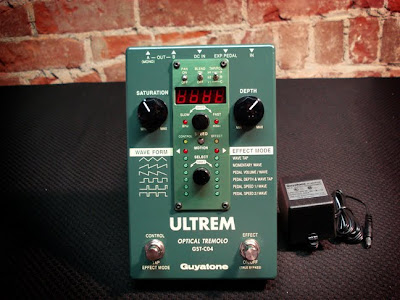
via
this Noisebug auction
"All Genoqs Nemos will ship with the newest OS, V1.60.
[
Update via Roderick in the comments "Sorry to nitpick...but the newest OS is
v1.62 .... :P"
New OS features include:
*Step Phrases, Phrase editing and Step Phrase Pool
*Explicit Step Polyphony
*Record Re-channeling
*Record Monitoring also in Stop mode
*Individual Page save/restore
*And much more!
Nemo is a high-end MIDI step sequencer, adding portability to the highly acclaimed functionality and user friendliness of Octopus. It is in many ways an Octopus in disguise, and one that feels equally well in a backpack or on your lap!
It features the same sequencing lighthouse features that Octopus users have enjoyed for years, including polyphonic steps, self-modulating and cross-modulating sequences, freely editable musical scales, user editable runtime directions, full-scale MIDI recording, and much more.
Nemo’s tactile and visual feedback, as in Octopus, is a physical experience so typical for traditional musical instruments. You know already that music is about your body as music is being felt, heard and played with Nemo. And the numbers behind it all.. no display? Well, do you really care? Yes, computers love them. We love light, color, and most of all music!
Nemo at a glance
- 90+ Tactile switches and 9 endless encoders for interactive access
- 93 LEDs (tri-color) used to display both numeric and quantitative data
- 64 pages (i.e. “patterns”)
- 4 tracks per page, 16 steps each
- 4 concurrent pages, i.e. 16 concurrent tracks
- Page tracks freely chain-able to structures of up to 64 steps
- Per track velocity, pitch, length and start factors, MIDI channel and CC
- Individual clock multiplier/divisor per track
- Individual and editable runtime directions per track
- Polyphonic steps, of up to 7 notes (chords or multi-trigger)
- Track self modulation, via step events
- Cross modulation of tracks (via the Effector)
- MIDI note and CC recording and playback per track
- 32 MIDI channels via 2 dedicated MIDI ports
The step sequencing overlord
- Internal resolution of 1/192ppq
- Dedicated controls for pitch, velocity, length and start of editable objects
- Free assignable control encoder for direct access to position, direction, groove, amount, MIDI CC and MIDI channel values.
- Select steps, tracks or pages using pressed buttons and edit them in realtime using the encoders
- Record MIDI on the fly and edit the material “natively” via the tactile user interface
- Step mode record and real-time record options
- Use encoders to remote control MIDI devices on the fly via MIDI CC (0-127)
- Sequencer operation modes: Grid, Page, Track, Step, Gridtrack
- Force to scale in preset or freely composable scales (exempt available)
- Steps may be pushed beyond or pulled ahead of the beat (+/- 5/192)
- Maximum structure length of 1024 steps, using 1 of 4 banks of pages
- Track cross modulation using the Effector: use a track to modulate other track(s)’ pitch, velocity, and controller amount
- 5 preset runtime directions, including random and pendulum
- 11 user-editable runtime directions
- Per track clock divisor and multiplier using values of 1, 1.5, 2, 3, 4, 5, 6, 7, 8, 16
- MIDI input may be used to trigger and transpose pages
- Step skip and track chaining easily produces tracks from 1-64 steps in length
- Polyphonic sequences - steps may carry chords of up to 7 notes, chord strum
- MIDI clock master or slave configuration, for full external sync flexibility
- OS upgradeable via MIDI sysex
- Full state save to flash for seamless operation between sessions
- MIDI Sysex data dump capability for external archiving
Connections
- MIDI: 2 in, 2 out
- Power: via supplied power adapter
- Interface: 91 pushbuttons, 9 encoders, 93 tri-colored LEDs
- Dimensions: 500 x 190 (in the middle) x 35 mm, 2 kg
- USB: device connector (computer interface)
- Lamp socket: USB format
Package contents
- Nemo sequencer
- 110/220V switching power adapter including cable for your geography
- Printed manual
Finally, think of Nemo as an Octopus in small: same OS, same technology, and to a very high degree the same features. The main differences are in the track capacity and in the more auditive aspect of operation of Nemo compared to the highly visual Octopus. In brief, the main functional constraints* with respect to Octopus are:
- 16 concurrent MIDI tracks (Octopus 90)
- 4 tracks per page (Octopus 10) or 64 steps, freely chain-able
- Direction editing capabilities constrained (i.e. no multiple location triggers per frame)
- 4 MCC stream resolution levels, with lowest and highest same as Octopus
- CC assignments to the MIX knobs are pre-set (i.e. no CC maps)
- Attribute map shapes are pre-set, access to map values available via step values
- Force to scale global, with page exemption available
- Step strums can be applied only to STA values, but not VEL, PIT, or LEN"

 via this Noisebug auction
via this Noisebug auction via this Noisebug auction
via this Noisebug auction
 via this Noisebug auction
via this Noisebug auction via this Noisebug auction
via this Noisebug auction











